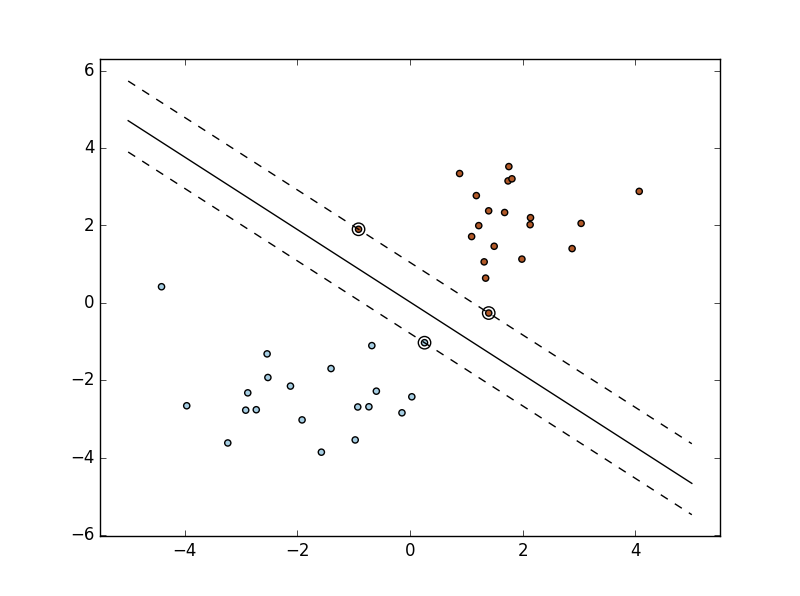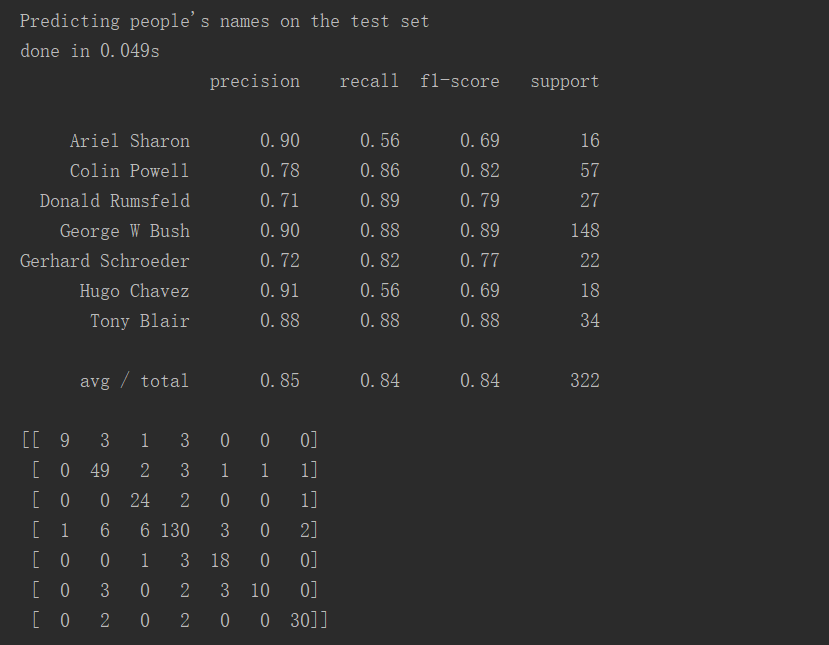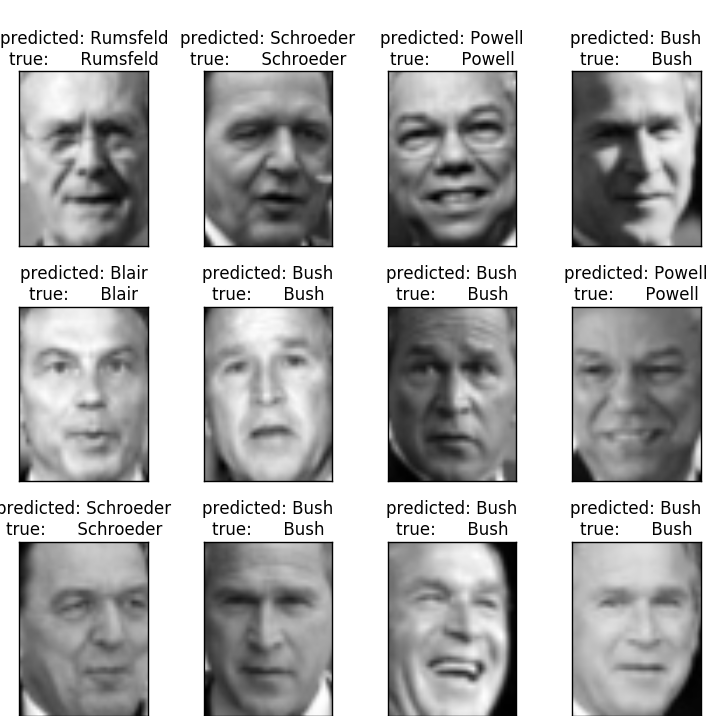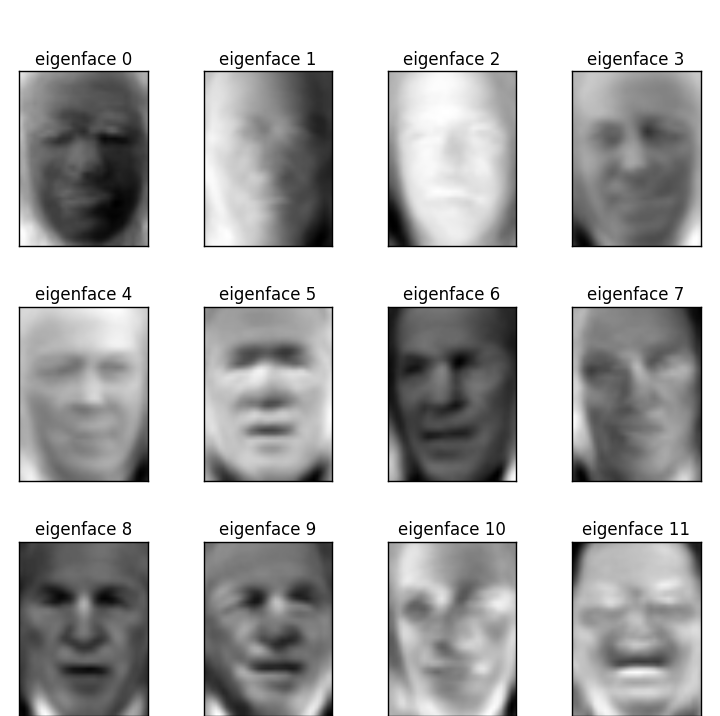第一部分:线性可分
通俗解释:可以用一条直线将两类分隔开来
一个简单的例子,直角坐标系中有三个点,A,B点为0类,C点为1类:
from sklearn import svm # 三个点 x = [[1, 1], [2, 0], [2, 3]] # 三个点所属类 y = [0, 0, 1] clf = svm.SVC(kernel='linear') clf.fit(x, y) # 所有信息 print(clf) # 支持向量 print(clf.support_vectors_) # 支持向量在x中的索引 print(clf.support_) # 支持向量在所属类中分别有几个 print(clf.n_support_) # 预测(1,4)这个点所属分类,结果是1类 print(clf.predict([[1, 4]]))
接下来多一些数据并画图观察下:
import numpy as np import pylab as pl from sklearn import svm # 按正态分布随机取40个样本 # 前20个取[-2,-2]点附近样本,后20个取[2,2]点附近样本,再用np.r_拼接 X = np.r_[np.random.randn(20, 2) - [2, 2], np.random.randn(20, 2) + [2, 2]] # 20个0类20个1类 Y = [0] * 20 + [1] * 20 # 调用sklearn的SVM clf = svm.SVC(kernel='linear') clf.fit(X, Y) # 参数 w = clf.coef_[0] ''' w_0x + w_1y +w_3=0方程转化为: y = -(w_0/w_1) x + (w_3/w_1) 其中w_3=clf.intercept_[0] ''' # 直线斜率 a = -w[0] / w[1] # 取-5到5之间的一些浮点数 xx = np.linspace(-5, 5) # 直线方程 yy = a * xx - (clf.intercept_[0]) / w[1] # 取第一个支持向量 b = clf.support_vectors_[0] # 下方直线方程(利用点斜式方程) yy_down = a * xx + (b[1] - a * b[0]) # 取最后一个支持向量 b = clf.support_vectors_[-1] # 上方直线方程(同理) yy_up = a * xx + (b[1] - a * b[0]) # 画出三条直线 pl.plot(xx, yy, 'k-') pl.plot(xx, yy_down, 'k--') pl.plot(xx, yy_up, 'k--') # 画出这些点 pl.scatter(clf.support_vectors_[:, 0], clf.support_vectors_[:, 1], s=80, facecolors='none') pl.scatter(X[:, 0], X[:, 1], c=Y, cmap=pl.cm.Paired) # 使坐标系的最大值和最小值与数据范围一致 pl.axis('tight') # 展示 pl.show()

第二部分:线性不可分
不可以用一条直线分割开来的数据
方法:转换成高维度
人脸识别案例:
from __future__ import print_function from time import time import logging import matplotlib.pyplot as plt from sklearn.cross_validation import train_test_split from sklearn.datasets import fetch_lfw_people from sklearn.grid_search import GridSearchCV from sklearn.metrics import classification_report from sklearn.metrics import confusion_matrix from sklearn.decomposition import RandomizedPCA from sklearn.svm import SVC # 打印日志 logging.basicConfig(level=logging.INFO, format='%(asctime)s %(message)s') # 装载数据集 lfw_people = fetch_lfw_people(min_faces_per_person=70, resize=0.4) # 处理图片相关信息 n_samples, h, w = lfw_people.images.shape X = lfw_people.data n_features = X.shape[1] y = lfw_people.target target_names = lfw_people.target_names n_classes = target_names.shape[0] print("Total dataset size:") print("n_samples: %d" % n_samples) print("n_features: %d" % n_features) print("n_classes: %d" % n_classes) # 设置训练集和测试集 # 随机选取75%的数据作为训练样本 # 其余25%的数据作为测试样本 X_train, X_test, y_train, y_test = train_test_split( X, y, test_size=0.25) # 降低维度(PCA算法) n_components = 150 print("Extracting the top %d eigenfaces from %d faces" % (n_components, X_train.shape[0])) t0 = time() pca = RandomizedPCA(n_components=n_components, whiten=True).fit(X_train) print("done in %0.3fs" % (time() - t0)) eigenfaces = pca.components_.reshape((n_components, h, w)) print("Projecting the input data on the eigenfaces orthonormal basis") t0 = time() X_train_pca = pca.transform(X_train) X_test_pca = pca.transform(X_test) print("done in %0.3fs" % (time() - t0)) # SVM算法 print("Fitting the classifier to the training set") t0 = time() param_grid = {'C': [1e3, 5e3, 1e4, 5e4, 1e5], 'gamma': [0.0001, 0.0005, 0.001, 0.005, 0.01, 0.1], } clf = GridSearchCV(SVC(kernel='rbf', class_weight='balanced'), param_grid) clf = clf.fit(X_train_pca, y_train) print("done in %0.3fs" % (time() - t0)) print("Best estimator found by grid search:") print(clf.best_estimator_) # 预测 print("Predicting people's names on the test set") t0 = time() y_pred = clf.predict(X_test_pca) print("done in %0.3fs" % (time() - t0)) print(classification_report(y_test, y_pred, target_names=target_names)) print(confusion_matrix(y_test, y_pred, labels=range(n_classes))) # 画图展示 def plot_gallery(images, titles, h, w, n_row=3, n_col=4): plt.figure(figsize=(1.8 * n_col, 2.4 * n_row)) plt.subplots_adjust(bottom=0, left=.01, right=.99, top=.90, hspace=.35) for i in range(n_row * n_col): plt.subplot(n_row, n_col, i + 1) plt.imshow(images[i].reshape((h, w)), cmap=plt.cm.gray) plt.title(titles[i], size=12) plt.xticks(()) plt.yticks(()) # 展示的每一张图标题(判断正误) def title(y_pred, y_test, target_names, i): pred_name = target_names[y_pred[i]].rsplit(' ', 1)[-1] true_name = target_names[y_test[i]].rsplit(' ', 1)[-1] return 'predicted: %sntrue: %s' % (pred_name, true_name) prediction_titles = [title(y_pred, y_test, target_names, i) for i in range(y_pred.shape[0])] # 原来的图片 plot_gallery(X_test, prediction_titles, h, w) eigenface_titles = ["eigenface %d" % i for i in range(eigenfaces.shape[0])] # 提取人脸特征的图片 plot_gallery(eigenfaces, eigenface_titles, h, w) plt.show()
数据相关信息:

PCA和SVM算法:

预测:

发现精确度达到85%,比较成功
观察矩阵:对角线代表预测与真实一致的个数
最后形象地看下:预测结果和真实基本一致

特征图:

转载于:https://www.cnblogs.com/xuyiqing/p/8779740.html
最后
以上就是阳光麦片最近收集整理的关于SVM算法简单应用的全部内容,更多相关SVM算法简单应用内容请搜索靠谱客的其他文章。
本图文内容来源于网友提供,作为学习参考使用,或来自网络收集整理,版权属于原作者所有。








发表评论 取消回复